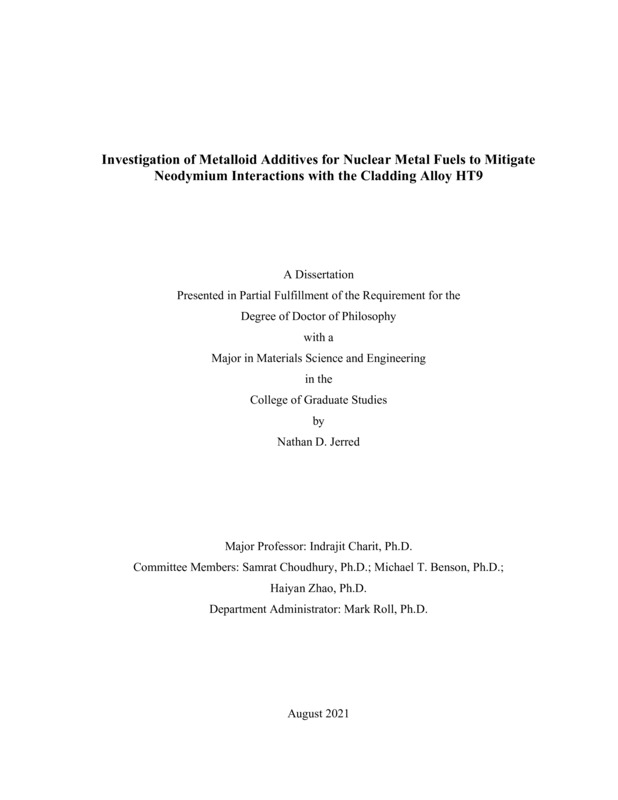Investigation of Metalloid Additives for Nuclear Metal Fuels to Mitigate Neodymium Interactions with the Cladding Alloy HT9
Jerred, Nathan. (2021-08). Investigation of Metalloid Additives for Nuclear Metal Fuels to Mitigate Neodymium Interactions with the Cladding Alloy HT9. Theses and Dissertations Collection, University of Idaho Library Digital Collections. https://www.lib.uidaho.edu/digital/etd/items/jerred_idaho_0089e_12046.html
- Title:
- Investigation of Metalloid Additives for Nuclear Metal Fuels to Mitigate Neodymium Interactions with the Cladding Alloy HT9
- Author:
- Jerred, Nathan
- ORCID:
- 0000-0003-2887-639X
- Date:
- 2021-08
- Embargo Remove Date:
- 2023-09-01
- Keywords:
- Dopants Fuel-based Additives Fuel-Cladding Chemical Interactions Lanthanides Metallic Nuclear Fuel U-10Zr
- Program:
- Materials Science
- Subject Category:
- Materials Science; Nuclear engineering
- Abstract:
-
The metalloid elements: antimony (Sb), tellurium (Te), and arsenic (As); along with the nonmetal element selenium (Se), are evaluated as fuel-based additives to mitigate the deleterious effects from chemical interactions that have been observed to occur at the fuel- cladding interface of the U-Zr metallic fuel system; a phenomenon known as fuel-cladding chemical interaction (FCCI). Lanthanide fission products, neodymium (Nd), cerium (Ce), praseodymium (Pr), and lanthanum (La), have been found to exhibit a high rate of interdiffusion with the primary cladding constituents, iron (Fe), chromium (Cr), and nickel (Ni). The FCCI phenomenon has been found to adversely affect the performance of metallic fuels due to the formation of both brittle and low-melting intermetallic phases. The formation of such phases leads to a loss of cladding wall integrity and can eventually lead to cladding failure. Alloying fuels with additives that will bind with and form high temperature stable compounds with lanthanide fission products, effectively stabilizing them within the fuel structure, has the potential to mitigate the major effects of the FCCI phenomenon.This research focuses on the efficacy of Sb, Te, and As additives and their stabilizing effects on the lanthanide Nd and ameliorate its interaction with the cladding alloy HT9. To evaluate the additive interactions and additive-lanthanide interactions within the U-Zr fuel structure, both U-10Zr-X and U-10Zr-X-Nd (wt.%) alloys, where ‘X’ denotes the additive, are fabricated. It is observed that X-Nd compounds preferentially form at a 1:1 atomic ratio within the U-Zr system. The ability of the additives to bind with Nd and alleviate its participation in FCCI is evaluated through isothermal diffusion couple studies carried out between U-10Zr-X- Nd alloys and the cladding alloy HT9 at temperatures up to 675°C. Although Fe is observed to diffuse to some degree into several of the additive-containing fuel alloys, Fe and Cr interaction with X-Nd phases was not observed. Further, atomistic models predicted both As and Se to be effective additives and further research on As found that within the U-Zr-As-Nd alloy the NdAs compound preferentially formed. Subsequent diffusion experiments between U-Zr-As-Nd against HT9 found the NdAs phase remains stable and no interaction with Fe or Cr was observed.
- Description:
- doctoral, Ph.D., Materials Science -- University of Idaho - College of Graduate Studies, 2021-08
- Major Professor:
- Charit, Indrajit
- Committee:
- Choudhury, Samrat; Zhao, Haiyan; Benson, Michael
- Defense Date:
- 2021-08
- Identifier:
- Jerred_idaho_0089E_12046
- Type:
- Text
- Format Original:
- Format:
- application/pdf
- Rights:
- In Copyright - Educational Use Permitted. For more information, please contact University of Idaho Library Special Collections and Archives Department at libspec@uidaho.edu.
- Standardized Rights:
- http://rightsstatements.org/vocab/InC-EDU/1.0/

